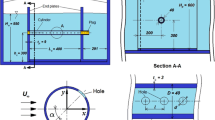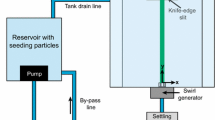Abstract
The hairpin packet's structure and its statistical scale in the later stage of bypass transition induced by a cylinder wake are investigated by time-resolved particle image velocimetry from the side and top view, respectively. Linear stochastic estimation is used to achieve the conditionally averaged velocity fields. For the side view case, the conditionally averaged structure consists of a series of swirling motions located along a line inclining at a large angle (18°) from the wall and a low-speed region occupied by the cylinder wake appearing right above them. In the (x, z)-plane at the wall-normal height y/δ = 0.2, the dominant structures are shown to be the large-scale regions of low momentum elongated almost over 3δ along the streamwise. The low-speed regions are consistently bordered by small-scale counter-rotating vortice pairs organized in the streamwise with a statistical spanwise width of 0.55δ. The results suggest that in the later part of the transitional zone, the upward induction of the cylinder wake enhances both the wall-normal and spanwise extent of the hairpin packets.









Similar content being viewed by others
Abbreviations
- D :
-
Diameter of circular cylinder
- PIV:
-
Particle image velocimetry
- rms:
-
Root mean square
- TBL:
-
Turbulent boundary layer
- TR:
-
Time-resolved
- u,v,w :
-
Instantaneous velocity components in x-(streamwise), y-(wall normal) and z-(spanwise) directions
- u′,v′,w′:
-
Fluctuation velocity components
- x,y,z :
-
Streamwise, wall normal and spanwise coordinates
- x c ,y c :
-
Streamwise and wall-normal position of the cylinder from the leading edge of the flat plate
- Re D :
-
Reynolds number based on diameter of circular cylinder
- Re τ :
-
Reynolds number based on u τ and δ
- δ:
-
Boundary layer thickness (0.99U ∞)
- 2D:
-
Two dimensional
References
Adrian RJ (1988) Linking correlations and structure: stochastic estimation and conditional averaging. In: Zoran P (ed) Zaric memorial international seminar on near-wall turbulence. Hemisphere, Dubrovnik
Adrian RJ (1996) Stochastic estimation of the structure of turbulent fields. In: Bonnet JP (ed) Eddy structure identification. Springer, New York, pp 145–195
Adrian RJ (2007) Hairpin vortex organization in wall turbulence. Phys Fluids 19:041301
Adrian RJ, Westerweel J (2011) Particle image velocimetry. Cambridge University Press, Cambridge
Adrian RJ, Meinhart CD, Tomkins CD (2000) Vortex organization in the outer region of the turbulent boundary layer. J Fluid Mech 422:1–54
Angrill F, Bergamaschi S, Cossalter V (1982) Investigation of wall induced modifications to vortex shedding from a circular cylinder. Trans ASME J Fluids Eng 104:518–522
Chakraborty P, Balachandar S, Adrian RJ (2005) On the relationship between local vortex identification schemes. J Fluid Mech 535:189–214
Chong MS, Perry AE, Cantwell BJ (1990) A general classification of three-dimensional flow fields. Phys Fluids A 2:765–777
Christensen KT (2004) The influence of peak-locking errors on turbulence statistics computed from PIV ensembles. Exp Fluids 36:484
Christensen KT, Adrian RJ (2001) Statistical evidence of hairpin vortex packets in wall turbulence. J Fluid Mech 431:433–443
Christensen KT, Adrian RJ (2002) Measurement of instantaneous Eulerian acceleration fields by particle-image accelerometry: method and accuracy. Exp Fluids 33:759
Doligalski TL, Smith CR, Walker JDA (1994) Vortex interactions with walls. Annu Rev Fluid Mech 26:573–616
Harvey JK, Perry FJ (1971) Flowfield produced by trailing vortices in the vicinity of the ground. AIAA 9:1659–1660
Hunt JCR, Wray AA, Moin P (1988) Eddies, stream, and convergence zones in turbulent flows. Technical Report CTR-S88, Stanford University, pp 193–208
Hutchins N, Marusic I (2007) Evidence of very long meandering features in the logarithmic region of turbulent boundary layers. J Fluid Mech 579:1–28
Hutchins N, Hambleton WT, Marusic I (2005) Inclined cross-stream stero particle image velocimetry measurements in turbulent boundary layers. J Fluid Mech 541:21–54
Jeong J, Hussain F (1995) On the identification of a vortex. J Fluid Mech 285:69–94
Krogstad PA, Antonia RA (1994) Structure of turbulent boundary layers on smooth and rough walls. J Fluid Mech 277:1–21
Kyriakides NK, Kastrinakis EG, Nychas SG, Goulas A (1999a) Aspects of flow structure during a cylinder wake-induced laminar/turbulent transition. AIAA J 37:1197–1205
Kyriakides NK, Kastrinakis EG, Nychas SG, Goulas A (1999b) A bypass wake induced laminar/turbulent transition. Eur J Mech B/Fluids 18:1049–1065
Mayle RE (1991) The role of laminar-turbulent transition in gas turbine engines. Trans ASME J Turbomach 113:509–537
Morkovin MV (1969) On the many faces of transition. In: Wells GS (ed) Viscous drag reduction. Plenum Press, New York, pp 1–31
Ovchinnikov V, Piomelli U, Choudhari MM (2006) Numerical simulations of boundary-layer transition induced by a cylinder wake. J Fluid Mech 547:413–441
Pan C, Wang JJ, Zhang PF, Feng LH (2008) Coherent structures in bypass transition induced by a cylinder wake. J Fluid Mech 603:367–389
Pan C, Wang JJ, Zhang C (2009) On the identification of Lagrangian coherent structures in turbulent boundary layer. Sci China G 52(1):248–257
Prasad AK, Adrian RJ, Landreth CC, Offutt PW (1992) Effect of resolution on the speed and accuracy of particle image velocimetry interrogation. Exp Fluids 13:105–116
Puel F, De Saint Victor X (2000) Interaction of wake vortices with the ground. Aerosp Sci Technol 4:239–247
Robinson SK (1991) Coherent motions in the turbulent boundary layer. Annu Rev Fluid Mech 23:601–639
Schlichting H (1968) Boundary layer theory. McGraw-Hill, New York
Smith CR, Walker JDA (1997) Sustaining mechanisms of turbulent boundary layers: the role of vortex development and interactions. In: Panton RL (ed) Self-sustaining mechanisms of wall turbulence. Adv Fluid Mech 15:13–47
Tang ZQ, Jiang N (2011) TR PIV experimental investigation on bypass transition induced by a cylinder wake. Chin Phys Lett 28(5):054702
Tomkins CD, Adrian RJ (2003) Spanwise structure and scale growth in turbulent boundary layers. J Fluid Mech 490:37–74
Westerweel J (1997) Fundamentals of digital particle image velocimetry. Meas Sci Technol 8:1379
Wu Y, Christensen KT (2006) Population trends of spanwise vortices in wall turbulence. J Fluid Mech 387:353–396
Zhou J, Adrian RJ, Balachandar S, Kendall TM (1999) Mechanism for generating coherent packets of hairpin vortices in channel flow. J Fluid Mech 387:353–396
Acknowledgments
This work was supported by the National Natural Science Foundation of China under grant no. 10832001 and 10872145, and the State Key Laboratory of Nonlinear Mechanics, Institute of Mechanics, Chinese Academy of Sciences.
Author information
Authors and Affiliations
Corresponding author
Rights and permissions
About this article
Cite this article
Tang, Z.Q., Jiang, N. Statistical scale of hairpin packets in the later stage of bypass transition induced by cylinder wake. Exp Fluids 53, 343–351 (2012). https://doi.org/10.1007/s00348-012-1291-7
Received:
Revised:
Accepted:
Published:
Issue Date:
DOI: https://doi.org/10.1007/s00348-012-1291-7




